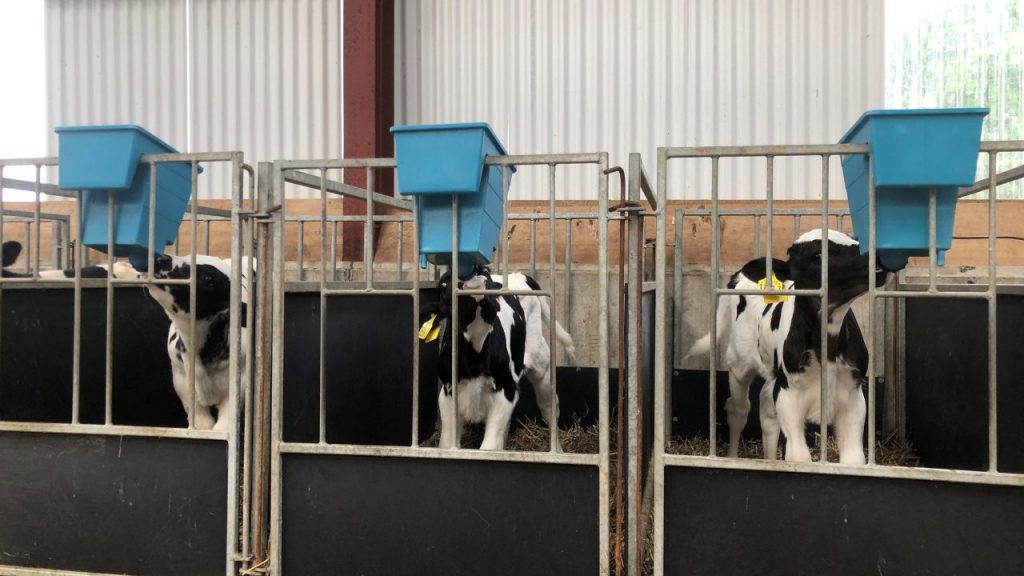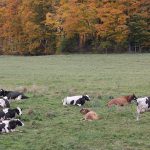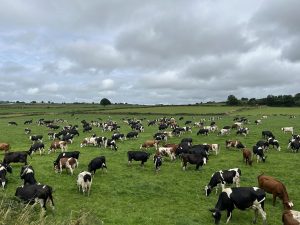
It is a well-known fact that the first 100 days for dairy heifers sets the precedent for the rest of her lifetime in dairying. This was the message of the day at a walk on the farm of Richard Brown, Millisle, Co. Down.
The first few weeks of life for a calf will have the biggest impact on heifer targets, and therefore the biggest impact on the profitability of your business.
Calves should receive sufficient quantities of high-quality colostrum within the first three hours of life to ensure they are given the best start at life.
As calves go from colostrum to milk powder, it is essential you know what you are feeding your calves to maintain a strong, healthy calf and to achieve sufficient growth rates.
Heifer targets
College of Agriculture, Food and Rural Enterprise (CAFRE) dairy advisers, Conail Keown and Anna Truesdale, as well as Trouw Nutrition’s calf nutrition specialist, Aaron Brown, were there on the day discussing growth targets, nutrition curves and how to unlock the maximum potential of youngstock in their first months of life.
Aaron calves his herd in an autumn block, with this year’s 70 Holstein replacement heifers already well on their way to achieving target weaning weights.
The target weights based on a calf birth weight of 40kg and a mature cow weight of 685kg from birth to 24-month calving, is as follows:
| Age | Target weight |
|---|---|
| One month | 55kg |
| Post Wean (three months) | 116kg |
| Pre-Breeding (13/14 months) | 377kg |
| Pre-Calving (24 months) | 582kg |
| Mature Weight | 685kg |
On the farm, a tight colostrum protocol is implemented, whereby every calf receives at least 10% of their body weight in the first few hours after birth.
From this stage on, Aaron focuses on ensuring good intakes of first transition milk, followed by a changeover onto a good quality milk replacer.
Rearing young heifers
The calf milk replacer is fed on a feed curve through an automatic feeder, in a light and airy shed with plenty of fresh bedding, fresh water, straw and an ad lib nut which the calves have access to.
Aaron provided a wealth of technical knowledge for the group on the day as he highlighted research showing how higher levels of growth can be consistently achieved.
He emphasised that a higher level of growth can be achieved when calves are fed around 1kg of milk powder, split into feeds of 4L or more, at least twice a day.

The farmers also discussed the importance of providing a fibre source to young calves, with chopped straw being the forage of choice.
This was because of its low energy density which encourages good simultaneous intakes of starter concentrate. Equally important is its ‘scratch mat’ properties, ensuring the calves rumen wall remains available for nutrient absorption.
Once the heifers reach five-to-six-weeks-of-age, the higher level of milk feeding can be reduced.
Aaron went on to explain how a gradual ‘step down’ approach then encourages an increase in starter intakes, reducing stress for both calf and calf-rearer in the weeks both pre and post weaning.
He continued that calves should ideally be weaned fully off milk by 10-12 weeks old having consumed a total of 35kg DM/head of starter feed by this stage.
“Weaning based on starter intake is a good place to begin”, explained Aaron, “we need to ensure that calves are achieving an adequate amount of energy from their concentrate feed before we remove the energy source that is milk”.
He said that instead of the traditional view on pushing concentrate intakes as early as possible, a higher level of milk feeding would be a more appropriate source of energy for the dairy calf in the first three-to-four-weeks-of-life.

The group were asked to think about their own calf rearing, with a few leaving the meeting considering several potential changes to unlock even better performance in their own calf houses.
In a time when every little helps and every little counts, it is crucial to make sure you’re getting your calf rearing right.
A few questions a farmer could ask himself are as follows:
- Is the environment correct?;
- Does your shed have a low humidity?;
- Is there clean fresh bedding?;
- Is there good ventilation with no draught?;
- Is there a clean source of water?
Water should not be forgotten, about as water can have a massive effect on calf health and growth in the first few weeks of life.
Aaron also pointed out that issues with incorrect concentrations can mean an imbalance in osmolality and an increase in gut problems for the developing calf.
A gradual weaning process is essential as weaning stress can induce a growth check at a time when the animal is genetically programmed to have one of the best feed conversion ratios and growth rates of its entire life.
The main aspect of heifer rearing is making you are hitting their weight targets and farmers should ‘measure to manage’, especially post weaning as it will provide a crucial insight into how well calf rearing is being managed on your own farm.
You can now read the most important #news on #eDairyNews #Whatsapp channels!!!
🇺🇸 eDairy News INGLÊS: https://whatsapp.com/channel/0029VaKsjzGDTkJyIN6hcP1K
























